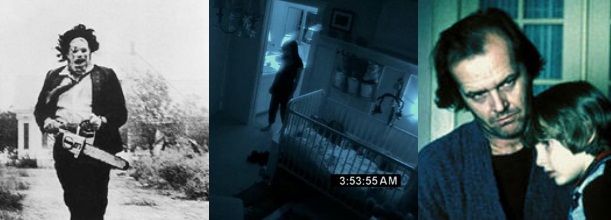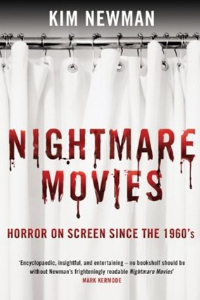Book review! Nightmare Movies: Horror On Screen Since The 1960s

Title:Nightmare Movies: Horror On Screen Since The 1960s Author:Kim Newman Publisher:Bloomsbury, 2011 |

|
A gory yet precise autopsy of horror films from the 1960s through to the 2000s, the expanded volume of Nightmare Movies sees author Newman bring his overview of post-1968 genre cinema up to date, reassessing his earlier evaluations and adding a second (300 page) part that examines the last two decades of nightmare movies, in the same intelligently witty, consistently incisive, and straight-talking manner for which he has come to be known.
Newman’s book says it like it is: in the world of cinema, nothing is really new, and almost all is a recycled, rehashed and remade version of something already contrived; the connections may not be obvious, yet Newman points to them expertly and effortlessly. His dissection of horror’s filmography is ordered according to the period, the cycle, the subgenre, the oeuvre, with irrefutable results – and from the ostensibly untouchables like Hitchcock’s The Birds to the widely maligned such as Eli Roth’s Hostel(s), no nightmare (or its reputation) is safe from the scalpel.

Consequently – as a thematically-ordered tome of horror knowledge – the contents page is nothing short of a veritable encyclopedia on all things imaginably (and unimaginably) frightening, from Devil movies, slasher flicks, neo-Gothic, virtual reality and Italian zombies, to paranoia, punk, postmodernism, post-Romero dead men and pornography. It’s a grisly buffet of familiar delights and exoticisms, upon which the exact premise of Newman’s Nightmare is artfully displayed: establishing early on the distinction and overlap between the ‘nightmare-movie’ and what is popularly, reductively defined as the ’horror film’, Newman makes it clear that non-genre works share – and influence – the collective “pool of scary ideas” as much as any straightforward creepshows. Such unexpected titles as The Breakfast Club, Con Air, and Rise of the Silver Surfer, and names like Jim Carrey and Charlie Chaplin pop up in what is a near-exhaustive, but intriguing depiction of the true face of the horror movie. What constitutes a nightmare goes beyond what the Romeros, Argentos or Carpenters envision, and its definition bleeds far further than what ‘conventional’ screen-horror presumes; consequently, with the expanded edition comes an expanded view on what it really means to be a horror fan. Newman is intent on driving home his central thesis that “the world is a more frightening place than is generally assumed”, and the book’s compulsion for comprehensiveness succeeds in doing just that.

This extension of cinematic horror does not however mean that every entry is worthy of the title; the chapters are saturated in what appears to be widespread disdain – the critic generously apportions his witty derision upon both the slick pastichists and the finesse-less originalish rarities in equal, hearty measure. The ruthless and seemingly rampant dismemberment of horror’s body of work means that one must wade through an infinite amount of carnage, but the crusade is rewarded by the triumphant “Auteurs” -two chapters that essentially bookend the rampage with some much-needed optimism. Admittedly, two chapters out of a total of twenty-two sounds like disillusionment, but reads like honesty. Newman pays homage where it’s due (Cronenberg, DePalma, del Toro, Lynch, et alii), and the spartan praise – when it eventually comes around – is thrillingly climactic.
The man is undoubtedly one of the coolest customers of a genre so inclined to both vitriolic contempt and defense, his arguments are balanced and convincing, and his aplomb in his convictions is thoroughly justified – even when the sacrosanct Hannibal Lecter is stripped of his title as an ‘authentic’ serial killer, we are assured by the masterful build-up and poetic, ingenious conclusions of the previous fourteen chapters that Newman is going somewhere with this, and it’s going to be good. (Another astounding example of his adroitly persuasive rhetoric is when he manages to substantiate the philosophical value of modern-day Creature Features with actual gravitas – Mark A.Z. Dippé’s Frankenfish included.)

Perhaps the driving force behind Newman’s credibility is his zero tolerance policy for bullshitting; the author is as honest and direct about films’ failings as he is about his own flawed evaluations (although all three editions of Nightmare Movies contain a strikingly admirable consistency of opinions). If the reader is to take just one page out of Newman’s extensive work, it is his readiness to revisit familiar and obscure texts, and his eager confrontation of the (albeit few) personal and collective misjudgements that stand in the way of a fuller, richer and unprejudiced enjoyment of the genre. Newman’s is a method that should plot the course of every professed horror fanatic.
Accurate, expository and straightforwardly smart, the book is very obviously the definitive analysis of horror on screen. Newman is a mastermind, and his unmatched critique covers all angles of the genre’s stagecraft – stylistic, conceptual, technical and ideological; there are no plot-holes in this scary story.





Recent Comments